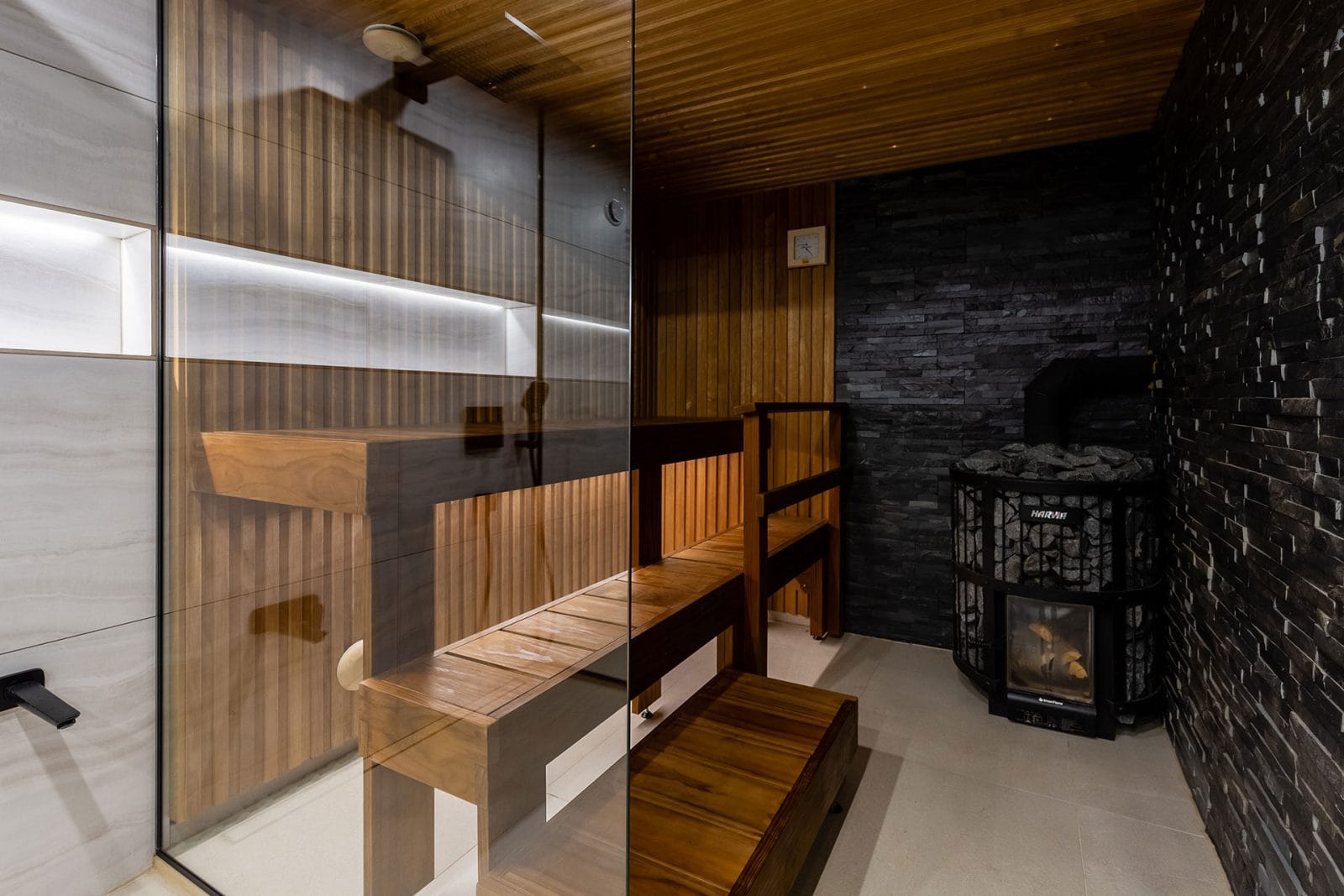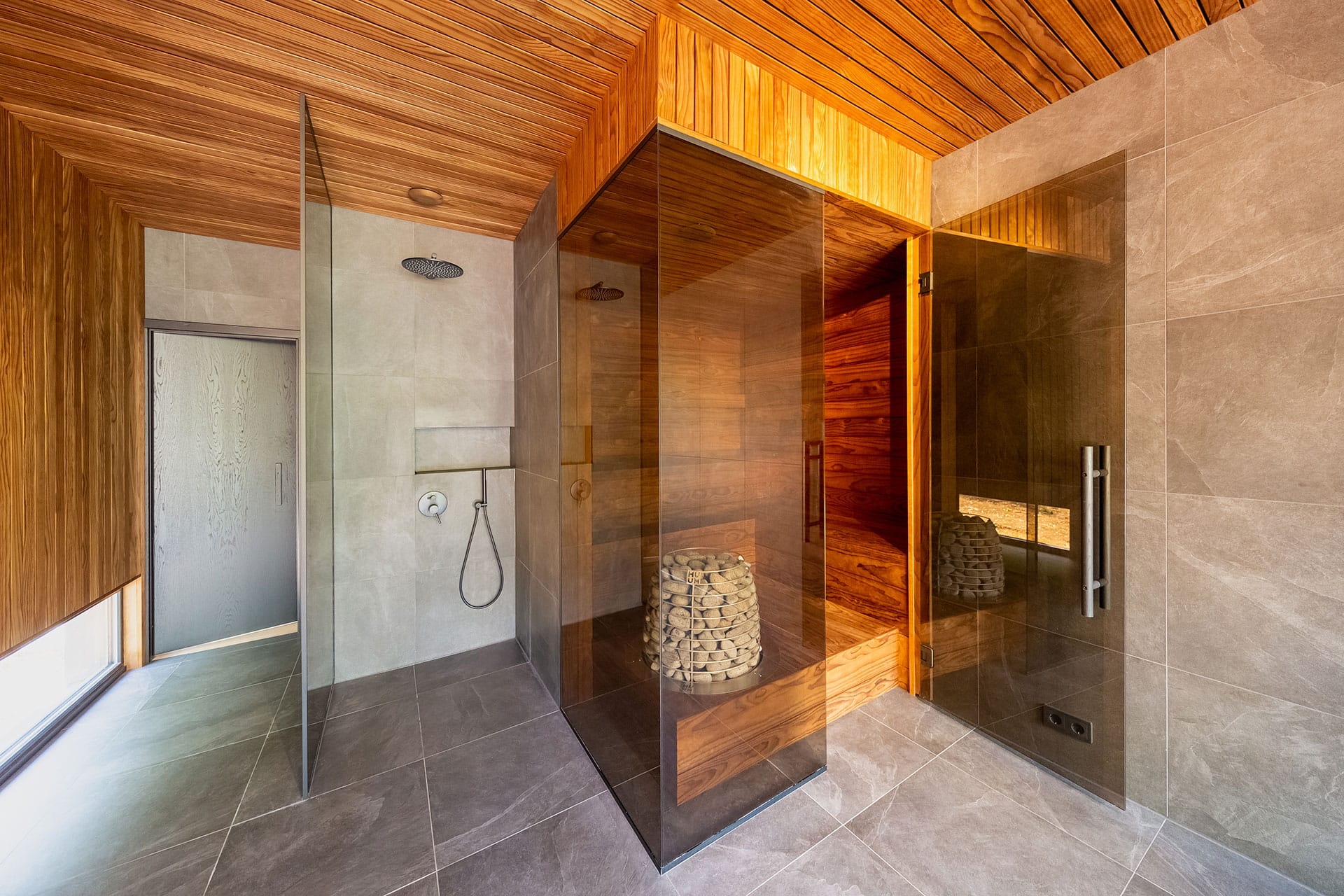Design Inspiration

Imagine stepping into your bathroom, not just to wash up, but to escape into a haven of tranquility. A sauna nestled within your bathroom can transform this space into a sanctuary of relaxation and rejuvenation.
Bathroom Layout with Sauna, Sauna in bathroom ideas
Designing a sauna bathroom requires thoughtful planning to create a functional and aesthetically pleasing space. Here’s a possible layout:
- Sauna: Position the sauna in a corner or against a wall, allowing for ample space for seating and relaxation. A compact sauna with a bench and a small door can be sufficient.
- Shower: Place the shower adjacent to the sauna for convenient access. Choose a spacious shower with a rain showerhead for a luxurious experience.
- Vanity: Position the vanity opposite the sauna, creating a clear separation between the relaxation zone and the grooming area.
- Storage: Utilize a wall-mounted cabinet or shelving unit near the vanity to store towels, toiletries, and sauna essentials.
Stylish and Functional Sauna Bathroom Designs
- Minimalist Design: This style emphasizes clean lines, neutral colors, and natural materials like wood and stone. A sleek, modern sauna with a minimalist design will complement this aesthetic.
- Scandinavian Design: This style features natural light, light wood, and simple, functional elements. A sauna with a wooden bench and a glass door will blend seamlessly into a Scandinavian bathroom.
- Rustic Design: This style incorporates rough-hewn wood, stone, and natural textures. A sauna with a traditional design, featuring a wood-burning stove and a wooden door, will add a touch of rustic charm.
Integrating Natural Light and Ventilation
- Skylight: A skylight can bring in natural light, making the bathroom feel brighter and more spacious. Position the skylight above the sauna for optimal light diffusion.
- Window: A large window can provide natural light and ventilation. Consider placing the window near the shower or vanity for a view of the outdoors.
- Exhaust Fan: An exhaust fan is essential for removing moisture and odors from the sauna. Install a powerful fan with a timer to ensure proper ventilation.
Materials for a Relaxing Sauna Ambiance
- Wood: Wood is a natural and warm material that is perfect for saunas. Choose cedar, redwood, or aspen for their durability and aroma.
- Stone: Stone can add a touch of elegance and sophistication to a sauna bathroom. Use granite, marble, or slate for flooring or wall accents.
- Tile: Tile is a versatile material that can be used for floors, walls, and even the sauna itself. Choose ceramic, porcelain, or natural stone tiles for a stylish and durable finish.
Sauna Installation: Sauna In Bathroom Ideas
Installing a sauna in your bathroom can be a rewarding project, adding a touch of luxury and wellness to your home. However, it’s crucial to ensure a safe and functional setup. This section will guide you through the essential steps involved in sauna installation, covering ventilation, electrical wiring, construction tips, and sealing techniques.
Ventilation
Proper ventilation is paramount for a safe and enjoyable sauna experience. It ensures fresh air circulation, prevents moisture buildup, and removes harmful gases.
- Exhaust Fan: Install an exhaust fan specifically designed for saunas. It should be powerful enough to remove hot, humid air efficiently. Choose a fan with a high CFM (cubic feet per minute) rating.
- Intake Vent: Provide a fresh air intake vent, preferably located opposite the exhaust fan. This allows fresh air to enter the sauna, replacing the expelled air.
- Placement: The exhaust fan should be positioned at the highest point of the sauna, while the intake vent should be near the floor level.
Electrical Wiring
Saunas require dedicated electrical circuits due to the high power consumption of the heater. Improper wiring can lead to electrical hazards, so it’s essential to follow safety guidelines.
- Dedicated Circuit: Install a separate circuit for the sauna heater, with a breaker rated for the heater’s amperage. This prevents overloading other circuits.
- GFCI Protection: Ensure the circuit includes a Ground Fault Circuit Interrupter (GFCI) outlet. GFCIs detect ground faults and interrupt the power supply, preventing electrical shocks.
- Professional Installation: Consult a qualified electrician for professional wiring installation. They can ensure proper connections and adherence to electrical codes.
Sauna Construction
Building a sauna involves constructing the bench, door, and heater. Each element requires specific considerations to ensure safety and functionality.
Sauna Bench
- Materials: Choose durable and heat-resistant materials for the bench, such as cedar, redwood, or aspen. These woods are naturally resistant to moisture and decay.
- Construction: Construct the bench with a slight incline to allow for comfortable seating and drainage. Use sturdy supports and fastenings to ensure stability.
- Placement: Position the bench at a comfortable height for sitting or lying down. Consider adding a second tier for additional seating options.
Sauna Door
- Materials: Opt for a lightweight yet sturdy door material, such as cedar or redwood. A glass door can enhance the sauna’s aesthetics but requires careful installation and safety considerations.
- Construction: The door should be well-insulated to prevent heat loss. Install a latch and handle that are easy to operate, even with sweaty hands.
- Seal: Ensure a tight seal around the door frame to minimize heat loss and prevent drafts. Use weatherstripping or a magnetic seal for optimal sealing.
Sauna Heater
- Type: Choose a sauna heater that’s appropriate for the size of your sauna. Electric heaters are commonly used in home saunas and offer convenient control.
- Installation: Install the heater according to the manufacturer’s instructions. Ensure it’s placed on a non-combustible surface and away from flammable materials.
- Stones: Load the heater with sauna stones, which absorb heat and release it as steam. Choose stones that are specifically designed for saunas.
Sealing
Sealing the sauna is crucial to prevent moisture damage and maintain optimal temperature.
- Materials: Use a high-quality sealant specifically designed for saunas. These sealants are moisture-resistant and can withstand high temperatures.
- Application: Apply the sealant around the sauna’s perimeter, including the walls, ceiling, and door frame. Ensure a smooth and even application for effective sealing.
- Maintenance: Inspect the sealant periodically for any signs of wear or damage. Reapply sealant as needed to maintain a proper seal.
Sauna Safety and Maintenance

Saunas can be a relaxing and rejuvenating experience, but it’s crucial to prioritize safety and proper maintenance to ensure a comfortable and enjoyable experience. Understanding the potential risks and implementing preventive measures will help you make the most of your sauna while minimizing any potential hazards.
Safety Precautions
Saunas are generally safe when used responsibly. However, it’s essential to be aware of potential risks and take necessary precautions.
- Hydrate Before and After: Before entering the sauna, drink plenty of water to prevent dehydration. Continue to drink water after your sauna session to replenish fluids lost through sweating.
- Avoid Alcohol and Drugs: Alcohol and drugs can impair your judgment and increase the risk of overheating. It’s best to avoid these substances before and during sauna use.
- Listen to Your Body: If you feel dizzy, lightheaded, or unwell, exit the sauna immediately and cool down. It’s important to respect your body’s limits and not push yourself too hard.
- Use a Timer: Set a timer to remind yourself to take breaks and avoid spending too much time in the sauna. Most experts recommend limiting sauna sessions to 15-20 minutes.
- Shower Before Entering: Showering before entering the sauna helps remove dirt and sweat, which can clog the pores and reduce the effectiveness of the sauna.
- Avoid Using Harsh Soaps: Using harsh soaps or detergents can irritate the skin, particularly when exposed to high temperatures. Use mild, fragrance-free soaps or body washes.
- Keep Children and Pets Away: Saunas can be dangerous for children and pets due to the high temperatures. Never leave children or pets unattended near a sauna.
Sauna Maintenance
Regular maintenance is essential for keeping your sauna clean, functional, and safe.
- Cleaning: Wipe down the sauna benches and walls with a damp cloth after each use. Use a mild soap solution if necessary, but avoid harsh chemicals that can damage the wood. You can also use a specialized sauna cleaner, but ensure it’s safe for wood surfaces.
- Ventilation: Proper ventilation is crucial for maintaining a safe and comfortable sauna environment. Ensure the sauna has adequate ventilation to remove moisture and prevent mold growth. Check the ventilation system regularly and clean any vents or filters as needed.
- Heater Maintenance: Follow the manufacturer’s instructions for maintaining the sauna heater. This may include checking the heating elements, cleaning the stove, and replacing any worn-out parts.
- Wood Care: The wood used in saunas is often treated to withstand high temperatures and moisture. Regularly inspect the wood for any signs of damage or deterioration. Apply a sauna-specific wood treatment or sealant as needed to protect the wood and prevent cracking or warping.
Potential Risks
While saunas can be beneficial for health, it’s important to be aware of potential risks associated with their use.
- Overheating: Spending too much time in a sauna can lead to overheating, which can cause dizziness, nausea, and even fainting. It’s essential to listen to your body and take breaks when needed.
- Dehydration: Sweating in a sauna can lead to dehydration, especially if you don’t drink enough fluids. Drinking plenty of water before, during, and after sauna sessions is crucial.
- Cardiovascular Issues: People with certain cardiovascular conditions should consult their doctor before using a sauna. High temperatures can put extra strain on the heart.
- Burns: The sauna heater and stove can become very hot, so it’s important to be careful when using them. Avoid touching the heater or stove directly, and keep children and pets away.
